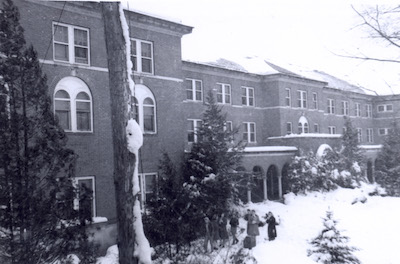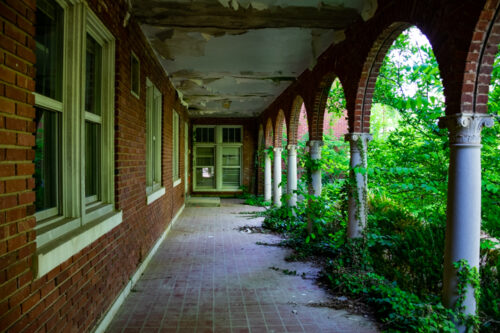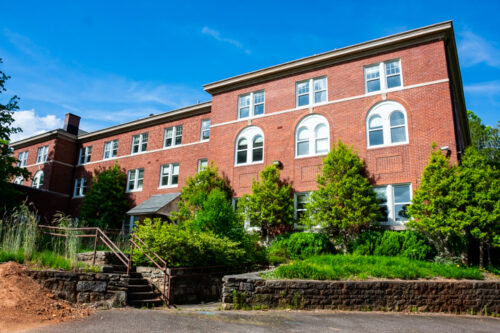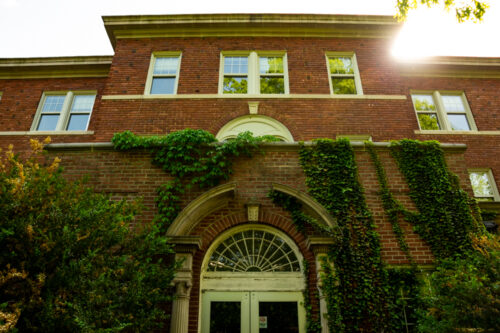Western Carolina University is full of architecture both new and old. Among some of the historical buildings that are still in use are the Breeze Gymnasium, McKee, Albright-Benton, and the University Auditorium. However, the grandfather of historical buildings still standing on campus today is the Moore building. Unfortunately, Moore has sat silent for years and few know its history, where it is, or even what it is. It’s time for a bit of campus history and an update!
According to an article that showcases historical architecture of the campus, the Moore building was built in 1924 and is deemed as the oldest building on the grounds. Its neighbor, the Joyner building, was destroyed by fire in 1981. Little has changed today since Joyner burned, as shown below in a before photo provided by the Southern Appalachian Digital Collections, and an after photograph taken by yours truly in the exact same location.


Moore got its name from Walter E. Moore, who was a Board of Trustees member, and the building began its life as a women’s dormitory.
May 30, 1924, saw the building’s dedication by President Madison to Walter E. Moore.
“Moore is a three-story fireproof brick building with ninety rooms, completely furnished, to take care of 180 girls,” Madison stated in a 1924 edition of the Cullowhee Yodel, a student-based paper.

The paper reported that the building was equipped with a family-style cafeteria, reading rooms and a reception hall. The building also hosted monthly public meetings in which women would receive lessons in being proper hosts for tea parties. Campus dining also found its way to the Moore building in 1930, and lasted for nearly 30 years until the current Brown Dining Hall was opened in 1957. According to a 2014 article published in the Western Carolina Journalist, Moore held an infirmary in its basement until the completion of Graham Hospital in 1939 and also harbored a morgue. This has sparked eerie stories throughout the year that suggest Moore is haunted.
Ghostly history

There are many stories that surround Moore suggesting the building has a ghost or two. According to a website that promotes haunted attractions in North Carolina, the Moore building has a grim legend to its past. There is much speculation, but the story suggests that two female roommates in the 1960s chose to stay in the dorm during break. One of the girls left the room to shower but was gone for an unusually long time. When the other girl went to investigate, she heard scratches and screams from the hallway. A repairman then walked by the dorm’s window and yelled up to the room that everything was okay, and for the girl to stay in her room. She remained and soon found out the other girl had been murdered, perhaps by the repairman.
It is said that the spirit of the murdered girl remained in Moore and could often be heard screaming and crying. The repairman was allegedly arrested and served time in a mental ward. Years later, a WCU student who worked for the campus radio station experienced eerie happenings in the building. One night when the station signal went out, the student headed to the Moore basement to reset the equipment located on the ground floor. He claims that the basement door shut behind him and also mentions he saw someone walk by a classroom door on the second floor when no one else was supposed to be in the building. Whether these stories are fact or fiction, who doesn’t’ love a good ghost story?

Other tales that surround Moore are rather lighthearted and are better grounded. According to the WCU Mountain Heritage Center, a Little Caesar statue once stood in front of Moore on the lawn and was donated by a class in the 1930s. Apparently, the statue was stolen by WCU’s rivals, the Appalachian State Teachers College, and was returned later, having been heavy vandalized.

So, what’s the scoop on Moore today?
The building hosted small meetings in the early 2000s and eventually was closed in 2012. In January last year, Jenkins Peer architects proposed a renovation of the building and highlighted some of the outstanding issues with the structure.
The report stated: “In the fall of 2021, WCU engaged Terracon to provide an updated Hazardous Materials surveys. The surveys found presence of the following items in various amounts: CFCs (chlorofluorocarbons) and PCBs (polychlorinated biphenyls) in switches and light fixtures, lead paint in various amounts throughout the building, some small areas of mold growth in specific locations, and asbestos containing materials mostly in floor tile mastics and flashings.”

Since the building’s closing, students often attempt to explore the interior of Moore. This is not just illegally trespassing on university property, but also endangers the health of those who force entry. Kaitlyn Pindur, a WCU Police Officer, described what kind of issues the force deals with regarding Moore.
“We get calls about students trespassing in Moore a good bit and actually had a break in last week. The students said they were ghost hunting,” Pindur said.
“We encourage students not to trespass because you’re not always going to get let go with a warning. We can and will criminally trespass anyone who breaks in.”
Until renovations hopefully come to fruition, Moore remains silent, abandoned, mysterious, and awaiting it’s future.



